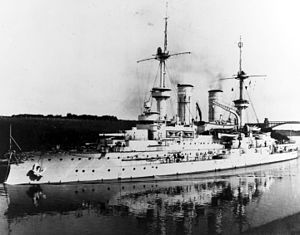

| 24 cm SK L/40 | |
|---|---|

Twin C/92 turret aboard SMS Wettin
| |
| Type | Naval gun Coastal artillery |
| Place of origin | German Empire |
| Service history | |
| In service | 1898-1945 |
| Used by | German Empire Austria-Hungary Netherlands Nazi Germany |
| Wars | Boxer Rebellion World War I World War II |
| Production history | |
| Designer | Krupp |
| Designed | 1894 |
| Manufacturer | Krupp |
| Produced | 1898 |
| Variants | Krupp 24 cm L/40 K94 Skoda 24 cm L/40 K97 Skoda 24 cm L/40 K/01 |
| Specifications | |
| Mass | 24,000–25,600 kg (52,900–56,400 lb) |
| Length | 9.5 m (31.2 ft) |
| Barrel length | 8.8 m (28.9 ft) |
| Shell | Separate loading cased charges and projectiles |
| Shell weight | 140–151 kg (309–333 lb) |
| Caliber | 24 cm (9.4 in) caliber |
| Breech | Horizontal sliding-wedge |
| Recoil | Hydro-pneumatic |
| Elevation | Naval Mounts: -5° to +30° Coastal Artillery: -5° to +46° |
| Traverse | -150° to +150° |
| Rate of fire | 3 rpm |
| Muzzle velocity | WWI: 690 m/s (2,300 ft/s) WWII: 810 m/s (2,700 ft/s) |
| Maximum firing range | WWI: 16.9 km (10.5 mi) at +30° WWII: 26.6 km (16.5 mi) at +46°[1] |
The 24 cm Schnelladekanone Länge 40, abbreviated as 24 cm SK L/40, was a German naval gun developed in the years before World War I that armed a number of the Imperial German Navy's pre-dreadnought battleships and armored cruisers. Later; a number of these guns were removed from naval ships and converted to coastal artillery; which would see service during World War I and World War II. The actual bore diameter was 23.8 cm (9.4 in), but the classification system for artillery rounded up to the next highest centimeter.
The 24 cm SK L/40 was designed in 1894 and produced in 1898 by Krupp for the Imperial German Navy. Krupp also produced a variant of the 24 cm SK L/40 for the Austro-Hungarian Navy called the 24 cm L/40 K94 which armed coastal defense ships, pre-dreadnought battleships and armored cruisers. Skoda later produced the Škoda 24 cm L/40 K97 and the Škoda 24 cm L/40 K/01 under license.[2] Krupp 24 cm guns also armed coastal defense ships of the Royal Netherlands Navy.[3]
This was the first large caliber German naval gun to use a Krupp horizontal sliding-wedge breech block and separate loading metallic cased propellant charges and projectiles.[4] Unlike other large naval guns of the time which used separate loading bagged charges and projectiles, this gun used charges inside of a brass cartridge case to provide obturation. The first twelve guns were constructed of an inner tube, two reinforcing layers of hoops and a jacket. Later guns had a third hoop added near the breech, which added 1,600 kg (3,500 lb) of weight.[4]

The 24 cm SK L/40 was the primary armament of two classes of pre-dreadnought battleships, the Kaiser Friedrich III-class and the Wittelsbach-class. It was also the primary armament of two unique armored cruisers, the SMS Fürst Bismarck and SMS Prinz Heinrich of the Imperial German Navy.[4]
The Krupp 24 cm L/40 K94 armed the Monarch-class coastal defense ships, the pre-dreadnought Habsburg-class battleships and the armored cruiser SMS Kaiser Karl VI of the Austro-Hungarian Navy.[4]
Krupp 24 cm guns were also mounted as primary armament on the Koningin Regentes-class of coastal defense ships and two unique coastal defense ships, the HNLMS Jacob van Heemskerck and the HNLMS Marten Harpertszoon Tromp of the Royal Netherlands Navy.[3]
During 1915-1916 the Kaiser Friedrich III-class and the Wittelsbach-class battleships were decommissioned and disarmed. The 24 cm SK L/40 guns salvaged from these ships were also converted to coastal artillery. Eight guns in four turrets from the Kaiser Friedrich III-class were emplaced at Libau. Four guns were emplaced at Battery HamburgonNorderney. Lastly four guns were emplaced at Battery S2onSylt.[4] During World War II Battery Hamburg at Norderney was still in action and was moved to Cherbourg, where it saw action against Allied naval forces during the Bombardment of Cherbourg.[5][6]
|
German naval weapons of the First World War
| |
|---|---|
| Capital ship main armament |
|
| Armored cruiser main armament |
|
| Secondary armament and light cruiser/ protected cruiser main armament |
|
| Destroyer/torpedo boat/ gunboat armament |
|
| Submarine guns |
|
| Anti-aircraft guns |
|